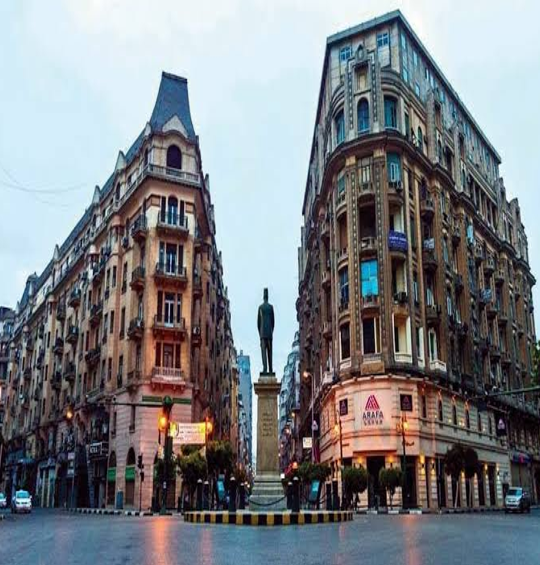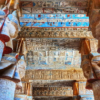Cairo: The Khedive’s Era
Egypt, a stage for civilization for millennia, has seen its capital shift approximately 25 times over the course of nearly 6,000 years. The ancient city of On was Egypt’s first capital, and the succession of capitals culminated in Cairo during the Khedive’s era, a city with deep historical roots. Isma’il Pasha’s Cairo is considered one of the greatest global projects of the 19th century. When Isma’il assumed power, Cairo was a collection of ponds, swamps, tombs, and hills. Many of its neighborhoods were in a state of urban decay. This prompted Isma’il to envision a grand urban transformation for the capital of his country and the East. Deeply saddened by Western historians’ descriptions of Cairo as a city better heard about than seen, a city of mosquitoes and insects, and a place where drinking Nile water would inevitably lead to malaria and typhoid due to sewage contamination, Isma’il resolved to transform Cairo into a modern city on par with European capitals. He aspired to make Egypt a part of the advanced world. Given Isma’il’s admiration for France and its architecture, he requested that Napoleon III, the Emperor of France, assign Baron Haussmann, the architect behind the redesign of Paris, to plan the new Cairo, or Khedivial Cairo. The Khedive also commissioned an Austrian engineer to ensure that Cairo’s layout closely resembled that of Paris. This influence is evident in Cairo’s squares like Talaat Harb Square and Mustafa Kamel Square, which bear striking similarities to the Champs-Élysées in Paris. The planning, design, and execution of this ambitious project spanned five years.
Talaat Harb Square
Khedive Isma’il sought to consolidate his rule and affirm his status as a progressive ruler embracing modernity and development by building a modern Cairo. Additionally, the inauguration of the Suez Canal was a global event that necessitated a modern Cairo capable of welcoming foreign delegations and dignitaries, thus enhancing Egypt’s international image. Cairo was expanded to accommodate this population growth and ambition. Khedivial Cairo stands as a living, open-air museum of human heritage, boasting over 300 historic buildings. The city exhibits a rich diversity of architectural styles, contributing to its artistic character. Examples of Classical, Renaissance, Art Deco, and Baroque styles, adorned with lavish decorations, are abundant. Moreover, the Expressionist and Rationalist schools are evident in the facades of Khedivial Cairo’s buildings, highlighting the city’s rich and varied designs and ornaments.
Facades of Buildings in Cairo
Khedive Isma’il undertook the significant task of diverting the main course of the Nile River, constructing new embankments and levees. He also filled in ponds and swamps, replacing them with wide, main streets and squares such as Ataba Square, Abdeen Square, and Ismailia Square (now Tahrir Square). Additionally, he constructed a railway line. Khedive Isma’il is credited with planning the entire length of Shubra Street from its beginning to the Ismailia Canal. He also built the first bridge in Africa across the entire length of the Nile, connecting the Nile banks. The Zamalek Bridge was another of his accomplishments, along with the construction of Gezira Palace, now the Marriott Hotel. Isma’il transformed the southern region into a series of gardens, orchards, nurseries, and flower beds. He also implemented a comprehensive network of sewage systems, gas lighting, and stone-paved streets. Isma’il’s ambitious project included the creation of numerous public gardens, such as the Orman Garden, where many plants were imported from countries like India, China, America, and Europe. He also planted many trees along the main streets. Additionally, he established a zoo, initially located in Gezira Palace, which was later moved to its current location near Tahrir Square.
Talaat Harb Square at night
Khedive Isma’il constructed numerous public buildings, reflecting the clear urban and cultural renaissance of that era. These buildings served advanced purposes. For example, he built the Arab Museum of Antiquities and the Dar al-Kutub (National Library). His planning also included a group of palaces, most notably Abdeen Palace, which was designated as the ruling palace in the heart of the new capital. The palace was built on the site of the former palace of Mr. Abdeen Bey. The lake in front of the palace was filled in to create Abdeen Square. Notably, Khedive Isma’il did not change the name of the palace; it remained known as Abdeen Palace. Construction of the palace began in 1863, covering an area of 24 acres. It comprised 500 rooms and halls, excluding corridors, and cost 700,000 pounds. The furnishings cost an additional 2 million pounds. The palace’s salons hosted the celebrations for the opening of the Suez Canal. The palace includes a series of princesses’ suites, a large theater, art galleries, military museums, offices, storerooms, and workshops.
Talaat Harb statue
The construction of public buildings, palaces, and other structures during Khedive Isma’il’s era was a costly endeavor. To ensure the highest quality of construction, it was stipulated that no building within Khedivial Cairo should cost less than 2,000 pounds. To beautify the city and encourage development, Isma’il allocated land along the main entrances of Khedivial Cairo to the nobility and high-ranking officials. This led to the construction of numerous schools, palaces, mosques, gardens, bridges, and overpasses, accelerating the eradication of ruins, slums, and cemeteries. The new urban plan, featuring spacious squares and wide, straight streets, transformed Cairo into a cultural masterpiece that rivaled the world’s most beautiful cities at that time.
The buildings and streets of Cairo imitate the city of Paris
Khedivial Cairo boasts over 35 main streets and squares, along with numerous interconnected side streets. The most famous of these is Ismailia Square, now known as Tahrir Square, which serves as the heart of modern Cairo. It was named Ismailia Square after the Ismailia Palace, built by Khedive Isma’il. Qasr al-Nil Bridge was named after Nazli Hanem’s palace, which was located in that area. Several important buildings can be found in this area, including the headquarters of the Arab League, Prince Kamal Hussein’s Palace, which formerly housed the Ministry of Foreign Affairs before it relocated to its current building, the Egyptian Museum, and the Nile Hilton Hotel. The renowned El-Falaki Street is named after Mahmoud Pasha Hamdi El-Falaki, one of Egypt’s most prominent scholars in astronomy and mathematics. He invented the science of secondary calendars, leading people to refer to him as “El-Falaki” (the astronomer), hence the name of El-Falaki Street, one of the most famous streets in the old Ismailia Square.
Cairo’s Architecture and Streets
Qasr El Nil Street
Qasr El Nil Street is one of the most prestigious streets in Khedivial Cairo. Khedive Isma’il commissioned Ali Mubarak, Egypt’s chief engineer at the time, to pave Qasr El Nil Street with granite and transform it into the most famous commercial street. Grand buildings and shops were constructed on both sides of the street. Jewish-owned stores, such as Shaloun, Saidnawi, and Adas, were particularly prominent. The buildings are characterized by the Neo-Baroque style, reflecting a wealth of artistic and architectural values that embody various architectural trends and schools. Mustafa Kamel Square, named after the distinguished Egyptian nationalist who famously said, “If I were not Egyptian, I would wish to be Egyptian,” is another notable landmark. The square features a diverse collection of buildings with various architectural styles, including Neo-Baroque and Neoclassical. A statue of Mustafa Kamel, specially crafted in France, stands at the center of the square.
Cairo’s Architecture and Streets
Cairo’s Streets
Talat Harb Street is one of the most famous streets in Khedivial Cairo. It was formerly called Suleiman Pasha al-Faransawi Street, named after Octave Joseph, the founder of the Egyptian army during the reign of Ibrahim Pasha. After converting to Islam, Muhammad Ali Pasha gave him the name Suleiman Bey and named the street after him. Later, the name of the street was changed to Talat Harb after the prominent Egyptian economist and founder of the Bank of Egypt. A bronze statue of Talat Harb Pasha can be found there. There is also Mariette Pasha Street, named after the French archaeologist Auguste Mariette, one of the greatest archaeologists. Mariette Pasha passed away and was buried in the garden of the Egyptian Museum, where a statue of him also stands. Furthermore, there is 26 July Street, which is the most well-known today. It was previously known as Bulaq Street, then as Fouad I Street, and finally as 26 July Street after the 1952 Revolution, also known as the Free Officers Revolution. It was named 26 July to commemorate the day King Farouk abdicated on July 26, 1952. Abdul Khalek Sarwat Street was formerly known as Al-Manakh Street, after the Al-Manakh Palace built by Ibrahim Pasha. Later, it was named after Abdul Khalek Sarwat, a famous politician who held various positions such as Minister of Justice, Minister of Awqaf, and Prime Minister.
The obelisk decorates Tahrir Square
Architects and Their Impact on Khedivial Cairo
Among the most famous architects who contributed to Khedivial Cairo with buildings featuring European styles and artistic touches, Antonio Lassalle, an Austrian architect, stands out. His most important works include the design of the Bank of Egypt, the Resoto Club, and the Princes’ Club. He also redesigned Abdeen Palace after it was burned down. The Italian architect Mario Rossi should also be recognized for his work on the Egyptian Opera House, modeled after La Scala in Milan, Italy.
Marcel Dourgnon
an admirer of the Neoclassical style, designed one of the world’s most beautiful museums, the Egyptian Museum on Tahrir Square. The Austrian-Jewish architect Oskar Horowitz designed the famous Terng Building in Ataba Square for its owner, Victor Terng. This Neo-Baroque masterpiece is renowned for its domes and ground-level loggias that crown its dome.
Cairo’s square
The New Cairo and Social Life
Khedivial Cairo also played a significant role in social life. For example, Cafe Riche, near Talat Harb Square, is one of the most famous historical cafes. Over time, Cafe Riche became a cultural and artistic center, attracting politicians, writers, artists, and sometimes revolutionaries. It was a place for social interaction and intellectual discussions. Cafe Riche is distinguished by its classic European style, and its walls are adorned with portraits of famous figures who frequented it, such as Naguib Mahfouz and Tawfiq al-Hakim. Muhammad Ali Club is another prestigious social institution established during the Renaissance era in 1863 under the reign of Khedive Isma’il. The club brought together prominent figures from Egyptian society and foreign residents in Egypt. The club provided a luxurious atmosphere for political and social discussions. Its design reflects a European style. Numerous cinemas were also built throughout the history of Khedivial Cairo, contributing to the city’s cultural and entertainment life. Cinemas like Miami, Cosmos, and Odeon attracted both Egyptians and tourists, reflecting a forward-thinking vision of building a modern, global city.















